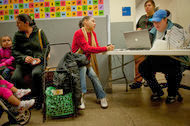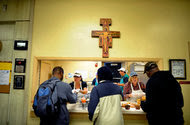 |
By Mac William Bishop
Bryan R. Smith for The New York Times
Cutting Back on Food Stamps: After Congress cut monthly benefits for food stamp recipients, families in the Bronx must make hard choices with reduced food budgets.
By KIM SEVERSON and WINNIE HU
Published: November 7, 2013
CHARLESTON, S.C. — For many, a $10 or $20 cut in the monthly food budget would be absorbed with little notice. 
Stephen Morton for The New York Times
Leon Simmons of Charleston, S.C., who on Monday had $5 left in food stamps for the month.

Bryan R. Smith for The New York Times
Ingrid Mock, center, at a food pantry in the Bronx on Monday. "I try to get most of the things my daughter eats because I can hold the hunger," she said.

Stephen Morton for The New York Times
Volunteers serving lunch this week at the Neighborhood House soup kitchen in Charleston, S.C.
And for many, it will mean turning to a food pantry or a soup kitchen by the middle of the month.
"I don't need a whole lot to eat," said Leon Simmons, 63, who spends more than half of his monthly $832 Social Security income to rent a room in an East Charleston house. "But this month I know I'm not going to buy any meats."
Mr. Simmons's allotment from the federal Supplemental Nutrition Assistance Program, commonly called food stamps, has dropped $9. He has already spent the $33 he received for November.
The reduction in benefits has affected more than 47 million people like Mr. Simmons. It is the largest wholesale cut in the program since Congress passed the first Food Stamps Act in 1964 and touches about one in every seven Americans.
From the country kitchens of the South to the bodegas of New York, the pain is already being felt.
Christopher Bean, the executive director of a Bronx food pantry that is operated by a nonprofit organization called Part of the Solution, said that about 60 new families had visited the pantry in the past week because their food stamps had been cut.
They know they will be out of food well before the month is over. "People can do math," he said.
In 2009, people started getting as much as 13.6 percent more in food stamps as part of the federal economic stimulus package, but that increase has expired. The reduction will save the government about $5 billion next year.
Over all, the nation's food stamps program cost a record $78.4 billion in the 2012 fiscal year, according to the Agriculture Department. Although the amount given to each household — a figure that can vary widely depending on a complex formula of income and the number of mouths to feed — has been dropping by small amounts for the past few years, the roster of people seeking assistance grew steadily through the recession.
In the 2010 fiscal year, 40.3 million people were enrolled. Two years later, that number jumped by 16 percent. Just over 45 percent of those getting food stamps are children, according to the Agriculture Department.
Food stamps are likely to be cut more in the coming years if Congress can agree on a new farm bill, which House and Senate negotiators began tackling this week. The Republican-controlled House has approved cutting as much as $40 billion from the program by making it harder to qualify. The Democratic-controlled Senate is suggesting a $4 billion cut by making administrative changes.
To poor families trying to stretch a couple hundred dollars into a month's worth of groceries, all the talk about stimulus packages, farm subsidies and congressional politics means little. It is all about daily survival at the grocery store.
"We'll be on our last $3 at the end of the month," said Rafaela Rivera, 34, a home health aide who earns $10 an hour.
Ms. Rivera's family of four saw their food stamps reduced by $36, to $420 a month. They pay rent and other expenses using her income and her husband's disability check, and they supplement food stamps with bags of fresh vegetables, chicken and other groceries from a food pantry.
"It's going to be hard," she said. "Our last week is going to be tight tight."
Ingrid Mock, 46, a former supermarket cashier who is disabled, was at the Bronx food pantry on Monday stocking up on canned green beans, pasta, ground beef and apples.
Ms. Mock, who has received food benefits for a decade and uses them to help feed her 12-year-old daughter, said her allotment had steadily decreased from as much as $309 about six years ago to a low of $250 this month, which reflected a new cut of $25.
Meanwhile, the price of staples like rice and corn oil have increased. So this month Ms. Mock will make choices. One dozen eggs instead of three, and only $1 worth of plantains. And no coffee or sugar for herself.
"I try to get most of the things my daughter eats because I can hold the hunger — I'm an adult — but she cannot," she said. "They don't understand when there's no food in the fridge."
The cuts are also hurting stores in poor neighborhoods. The average food stamps household receives $272 a month, which then passes into the local economy.
At a Food Lion in Charleston where as many as 75 percent of the shoppers use food stamps, managers were bracing for lower receipts as the month wore on.
At a Met Foodmarket in the Bronx, where 80 percent of the 7,000 weekly customers use food stamps, overall food sales have already dropped by as much as 10 percent.
"I wasn't expecting it to be that fast," said Abraham Gomez, the manager. Losing that much revenue could mean cutting back hours for employees, he said.
Although several pilot programs around the country are designed to help people with food stamps eat better, including one by a Connecticut organization called Wholesome Wave that doubles the value of food stamps used at farmers' markets, Mr. Gomez and others worry that less money for food means resorting to more dried noodles and canned tuna and fewer fresh vegetables and healthier cuts of meat.
Elliot Porter, 46, whose food stamps benefit dropped to $189 a month from $200, is a former property manager who is technically homeless but living with a friend while he goes to college.
At the Met Foodmarket this week, Mr. Porter had to perform a calculation with everything he reached for on the shelves, weighing his personal taste against cost and health.
A nutritionist who is helping him lose weight to avoid diabetes told him to buy a natural brand of peanut butter without sugar. But it cost $4.39. He decided he could afford only the store brand with sugar, which cost $3.79.
His situation may be better than many. During lunch at the Neighborhood House soup kitchen in Charleston this week, discussions about how to cope with cuts to food stamps were not hard to find.
People said they felt desperate. Many stuffed extra bread or cake into their pockets for later in the day, and traded advice on which agencies might be handing out free groceries later in the month.
No comments:
Post a Comment